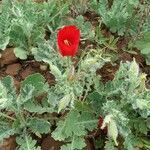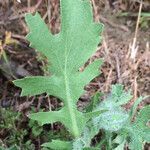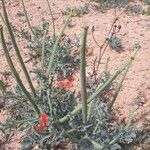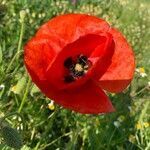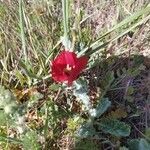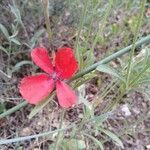An annual herb. It has bristles. When damaged it has a yellow latex. The leaves are alternate and deeply divided into lobes with irregular teeth. The lower leaves are much smaller than the leaves on the stem. The upper leaves clasp the stem. The flowers are red. They are on thick stems. The four red petals have a black blotch near the middle. The stamens are yellow. The fruit is an elongated capsule or pod. It is covered with short bristles. The capsule opens from the top downwards. The plant dries off after flowering.
Plant annual or occasionally biennial, to 0.5 m high. Leaves to 25 cm long; lamina pinnately lobed or parted, deeply dentate; basal leaves almost glabrous to moderately pubescent; lower leaves lyrate; upper leaves ovate, sometimes slightly cordate-clasping. Pedicel stout, to 5 cm long. Sepals 15–30 mm long. Petals obovate, to 40 mm long, orange to reddish orange, usually with a blackish basal spot. Capsule straight or somewhat arcuate, to 25 cm long, appressed-to ascending-pubescent or almost glabrous.
